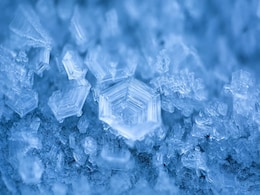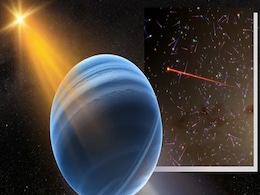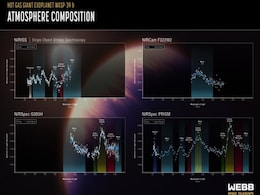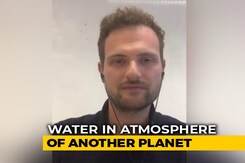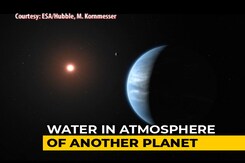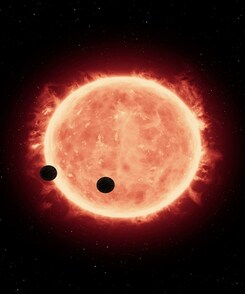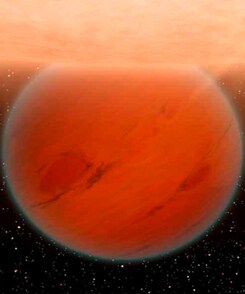Planet Exoplanet
- All
- News
- Videos
- Web Stories
-

Alien Life May Survive on Planets Orbiting White Dwarfs, Study Finds
- Wednesday March 26, 2025
- Written by Gadgets 360 Staff
New research explores the possibility of alien life on planets orbiting white dwarfs. While these stellar remnants cool over time, their shrinking habitable zones may still allow biological processes like photosynthesis and UV-driven abiogenesis to occur. A model assessing a planet's energy reception over seven billion years indicates that life-sus...
-
 www.gadgets360.com
www.gadgets360.com
-

NASA's Webb Captures First Direct Images Of Carbon Dioxide Outside Solar System
- Tuesday March 18, 2025
- Science | Edited by Ritu Singh
This finding provides compelling evidence that the giant planets in HR 8799 formed through core accretion, a process similar to the formation of Jupiter and Saturn.
-
 www.ndtv.com
www.ndtv.com
-

James Webb Space Telescope Observes Mysterious Rogue Planet-Like Object
- Thursday March 6, 2025
- Written by Gadgets 360 Staff
The James Webb Space Telescope has captured new insights into SIMP 0136, a planetary-mass object floating freely around 20 light-years away. This celestial body, possibly a rogue planet or a brown dwarf, has puzzled astronomers for years. JWST’s infrared observations have revealed intricate cloud layers, temperature shifts, and potential chemical...
-
 www.gadgets360.com
www.gadgets360.com
-

In A First, Astronomers Reveal 3D Structure Of Alien Planet's Atmosphere
- Wednesday February 19, 2025
- World News | Reuters
Astronomers for the first time have deciphered the three-dimensional structure of the atmosphere of a planet beyond our solar system.
-
 www.ndtv.com
www.ndtv.com
-

Scientists Observe Rare Plastic Ice, A Hybrid Form of Ice and Water, Under Extreme Pressure and Heat
- Thursday February 20, 2025
- Written by Gadgets 360 Staff
Researchers have observed plastic ice, a phase where water molecules rotate while staying in a solid structure. The discovery, made under extreme pressure and heat, could provide new insights into the composition of icy exoplanets and moons. The findings suggest plastic ice VII may have existed in Europa and Titan's interiors and could influence nu...
-
 www.gadgets360.com
www.gadgets360.com
-

Exoplanet WASP-121 b’s Atmosphere Features Iron Rains, Jet Streams, and More
- Thursday February 20, 2025
- Written by Gadgets 360 Staff
Astronomers have uncovered extreme weather patterns on WASP-121 b, a gas giant 900 light-years from Earth. The planet experiences iron rain, with metals vaporizing on its scorching dayside and condensing into liquid at night. Supersonic winds carry elements across its atmosphere, forming powerful jet streams. Using the Very Large Telescope, researc...
-
 www.gadgets360.com
www.gadgets360.com
-

A Neptune-Like Exoplanet Is Racing Through Space at Record Speed
- Monday February 17, 2025
- Written by Gadgets 360 Staff
Scientists have detected an exoplanet racing through space at 1.2 million mph, making it the fastest known planet. The Neptune-sized world orbits a hypervelocity star, first hinted at in 2011 via gravitational microlensing. Astronomers, using Keck Observatory and Gaia data, have confirmed the system’s extreme speed, suggesting it may even leave t...
-
 www.gadgets360.com
www.gadgets360.com
-

Astronomers Spot a High-Speed Star That May Carry a Planet With It
- Friday February 14, 2025
- Written by Gadgets 360 Staff
Astronomers have identified a celestial object moving through the Milky Way at over 1.2 million mph. Believed to be a small star with a possible massive exoplanet, the discovery could mark the fastest-known planetary system. If its speed exceeds 1.3 million mph, it may eventually escape the galaxy. Scientists are still verifying whether it is the s...
-
 www.gadgets360.com
www.gadgets360.com
-

A Star With a Planet May Be Racing Through the Galaxy at Record Speed
- Wednesday February 12, 2025
- Written by Gadgets 360 Staff
Astronomers have identified a potential record-breaking exoplanet system moving at 1.2 million mph. Detected through microlensing, the discovery suggests a low-mass star with an orbiting planet is racing through the Milky Way. Data from the Keck Observatory and ESA’s Gaia satellite indicate a high-speed celestial body that may eventually escape t...
-
 www.gadgets360.com
www.gadgets360.com
-

Newly Confirmed Super-Earth HD 20794 d May Support Life in Habitable Zone
- Tuesday February 11, 2025
- Written by Gadgets 360 Staff
A super-Earth, HD 20794 d, has been confirmed within a habitable zone 20 light years from Earth. The planet, first detected in 2022, has a mass six times that of Earth and orbits a sun-like star. Although its elliptical orbit affects temperature stability, its potential to sustain liquid water makes it a key target for upcoming space missions. Scie...
-
 www.gadgets360.com
www.gadgets360.com
-

NASA's TESS Discovers Fastest Disintegrating Planet Ever Seen: What You Need to Know
- Monday January 20, 2025
- Written by Gadgets 360 Staff
NASA’s TESS has observed the closest and fastest disintegrating planet, BD+05 4868 Ab, located 141 light-years away. The planet loses a moon’s mass every million years as it is bombarded by its host star. Scientists are examining its massive dust trails, offering rare insights into the composition of terrestrial exoplanets. Researchers from MIT...
-
 www.gadgets360.com
www.gadgets360.com
-

Astronomers Discover Water and Carbon Dioxide in WASP-166 b's Atmosphere
- Saturday January 11, 2025
- Written by Gadgets 360 Staff
Astronomers have detected water and carbon dioxide in the atmosphere of WASP-166 b, a hot super-Neptune exoplanet. Using data from the James Webb Space Telescope (JWST), the findings also noted ammonia in smaller quantities. WASP-166 b, located 368 light-years away, is a massive planet that orbits its star every 5.44 days, with a temperature of 1,2...
-
 www.gadgets360.com
www.gadgets360.com
-

New Study Challenges Planet Formation Models with PDS 70b’s Chemical Mystery
- Thursday December 19, 2024
- Written by Gadgets 360 Staff
A new study on PDS 70b, a forming exoplanet located 400 light-years away, reveals a significant mismatch between its atmospheric composition and the surrounding protoplanetary disk. This discovery casts doubt on existing planet formation models, suggesting that more research is needed to understand how planets gather materials and elements during t...
-
 www.gadgets360.com
www.gadgets360.com
-

Scientists Discover 563,000-Km Comet-Like Tail On Exoplanet WASP-69 B
- Saturday December 14, 2024
- Science | Edited by NDTV News Desk
A team of scientists has discovered that WASP-69 b, an exoplanet, has a comet-like tail of gas, stretching up to 563,000 kilometresinto space.
-
 www.ndtv.com
www.ndtv.com
-

Venus Never Had Oceans or Conditions to Support Life, New Study Finds
- Monday December 9, 2024
- Written by Gadgets 360 Staff
Scientists from the University of Cambridge have concluded that Venus likely never had oceans or conditions to support life. Their study, published in Nature Astronomy, analysed atmospheric chemistry and volcanic activity. They found that volcanic gases lacked significant steam, indicating the planet's interior has always been dry. This research ha...
-
 www.gadgets360.com
www.gadgets360.com
-

Alien Life May Survive on Planets Orbiting White Dwarfs, Study Finds
- Wednesday March 26, 2025
- Written by Gadgets 360 Staff
New research explores the possibility of alien life on planets orbiting white dwarfs. While these stellar remnants cool over time, their shrinking habitable zones may still allow biological processes like photosynthesis and UV-driven abiogenesis to occur. A model assessing a planet's energy reception over seven billion years indicates that life-sus...
-
 www.gadgets360.com
www.gadgets360.com
-

NASA's Webb Captures First Direct Images Of Carbon Dioxide Outside Solar System
- Tuesday March 18, 2025
- Science | Edited by Ritu Singh
This finding provides compelling evidence that the giant planets in HR 8799 formed through core accretion, a process similar to the formation of Jupiter and Saturn.
-
 www.ndtv.com
www.ndtv.com
-

James Webb Space Telescope Observes Mysterious Rogue Planet-Like Object
- Thursday March 6, 2025
- Written by Gadgets 360 Staff
The James Webb Space Telescope has captured new insights into SIMP 0136, a planetary-mass object floating freely around 20 light-years away. This celestial body, possibly a rogue planet or a brown dwarf, has puzzled astronomers for years. JWST’s infrared observations have revealed intricate cloud layers, temperature shifts, and potential chemical...
-
 www.gadgets360.com
www.gadgets360.com
-

In A First, Astronomers Reveal 3D Structure Of Alien Planet's Atmosphere
- Wednesday February 19, 2025
- World News | Reuters
Astronomers for the first time have deciphered the three-dimensional structure of the atmosphere of a planet beyond our solar system.
-
 www.ndtv.com
www.ndtv.com
-

Scientists Observe Rare Plastic Ice, A Hybrid Form of Ice and Water, Under Extreme Pressure and Heat
- Thursday February 20, 2025
- Written by Gadgets 360 Staff
Researchers have observed plastic ice, a phase where water molecules rotate while staying in a solid structure. The discovery, made under extreme pressure and heat, could provide new insights into the composition of icy exoplanets and moons. The findings suggest plastic ice VII may have existed in Europa and Titan's interiors and could influence nu...
-
 www.gadgets360.com
www.gadgets360.com
-

Exoplanet WASP-121 b’s Atmosphere Features Iron Rains, Jet Streams, and More
- Thursday February 20, 2025
- Written by Gadgets 360 Staff
Astronomers have uncovered extreme weather patterns on WASP-121 b, a gas giant 900 light-years from Earth. The planet experiences iron rain, with metals vaporizing on its scorching dayside and condensing into liquid at night. Supersonic winds carry elements across its atmosphere, forming powerful jet streams. Using the Very Large Telescope, researc...
-
 www.gadgets360.com
www.gadgets360.com
-

A Neptune-Like Exoplanet Is Racing Through Space at Record Speed
- Monday February 17, 2025
- Written by Gadgets 360 Staff
Scientists have detected an exoplanet racing through space at 1.2 million mph, making it the fastest known planet. The Neptune-sized world orbits a hypervelocity star, first hinted at in 2011 via gravitational microlensing. Astronomers, using Keck Observatory and Gaia data, have confirmed the system’s extreme speed, suggesting it may even leave t...
-
 www.gadgets360.com
www.gadgets360.com
-

Astronomers Spot a High-Speed Star That May Carry a Planet With It
- Friday February 14, 2025
- Written by Gadgets 360 Staff
Astronomers have identified a celestial object moving through the Milky Way at over 1.2 million mph. Believed to be a small star with a possible massive exoplanet, the discovery could mark the fastest-known planetary system. If its speed exceeds 1.3 million mph, it may eventually escape the galaxy. Scientists are still verifying whether it is the s...
-
 www.gadgets360.com
www.gadgets360.com
-

A Star With a Planet May Be Racing Through the Galaxy at Record Speed
- Wednesday February 12, 2025
- Written by Gadgets 360 Staff
Astronomers have identified a potential record-breaking exoplanet system moving at 1.2 million mph. Detected through microlensing, the discovery suggests a low-mass star with an orbiting planet is racing through the Milky Way. Data from the Keck Observatory and ESA’s Gaia satellite indicate a high-speed celestial body that may eventually escape t...
-
 www.gadgets360.com
www.gadgets360.com
-

Newly Confirmed Super-Earth HD 20794 d May Support Life in Habitable Zone
- Tuesday February 11, 2025
- Written by Gadgets 360 Staff
A super-Earth, HD 20794 d, has been confirmed within a habitable zone 20 light years from Earth. The planet, first detected in 2022, has a mass six times that of Earth and orbits a sun-like star. Although its elliptical orbit affects temperature stability, its potential to sustain liquid water makes it a key target for upcoming space missions. Scie...
-
 www.gadgets360.com
www.gadgets360.com
-

NASA's TESS Discovers Fastest Disintegrating Planet Ever Seen: What You Need to Know
- Monday January 20, 2025
- Written by Gadgets 360 Staff
NASA’s TESS has observed the closest and fastest disintegrating planet, BD+05 4868 Ab, located 141 light-years away. The planet loses a moon’s mass every million years as it is bombarded by its host star. Scientists are examining its massive dust trails, offering rare insights into the composition of terrestrial exoplanets. Researchers from MIT...
-
 www.gadgets360.com
www.gadgets360.com
-

Astronomers Discover Water and Carbon Dioxide in WASP-166 b's Atmosphere
- Saturday January 11, 2025
- Written by Gadgets 360 Staff
Astronomers have detected water and carbon dioxide in the atmosphere of WASP-166 b, a hot super-Neptune exoplanet. Using data from the James Webb Space Telescope (JWST), the findings also noted ammonia in smaller quantities. WASP-166 b, located 368 light-years away, is a massive planet that orbits its star every 5.44 days, with a temperature of 1,2...
-
 www.gadgets360.com
www.gadgets360.com
-

New Study Challenges Planet Formation Models with PDS 70b’s Chemical Mystery
- Thursday December 19, 2024
- Written by Gadgets 360 Staff
A new study on PDS 70b, a forming exoplanet located 400 light-years away, reveals a significant mismatch between its atmospheric composition and the surrounding protoplanetary disk. This discovery casts doubt on existing planet formation models, suggesting that more research is needed to understand how planets gather materials and elements during t...
-
 www.gadgets360.com
www.gadgets360.com
-

Scientists Discover 563,000-Km Comet-Like Tail On Exoplanet WASP-69 B
- Saturday December 14, 2024
- Science | Edited by NDTV News Desk
A team of scientists has discovered that WASP-69 b, an exoplanet, has a comet-like tail of gas, stretching up to 563,000 kilometresinto space.
-
 www.ndtv.com
www.ndtv.com
-

Venus Never Had Oceans or Conditions to Support Life, New Study Finds
- Monday December 9, 2024
- Written by Gadgets 360 Staff
Scientists from the University of Cambridge have concluded that Venus likely never had oceans or conditions to support life. Their study, published in Nature Astronomy, analysed atmospheric chemistry and volcanic activity. They found that volcanic gases lacked significant steam, indicating the planet's interior has always been dry. This research ha...
-
 www.gadgets360.com
www.gadgets360.com





